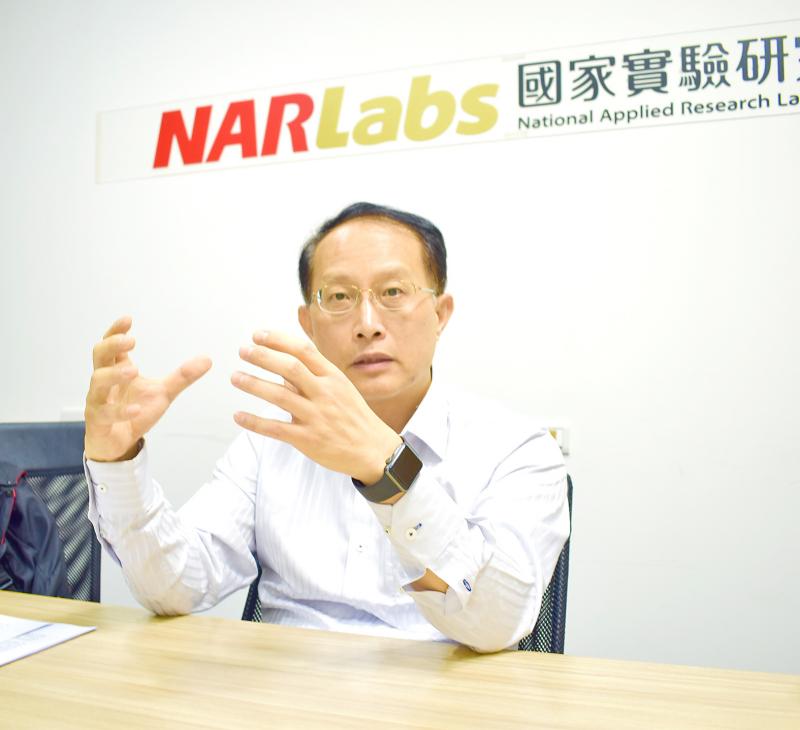With the National Space Organization (NSPO) — which is to mark its 30th anniversary in October — to be reorganized into a higher agency, questions have been raised as to how it would chart a new course in space development.
This year is crucial for the agency. Last month, it pushed the nation’s first space development bill through a legislative review. Once the regulations are in place, the organization is to be upgraded into an agency directly supervised by the Ministry of Science and Technology.
One of the NSPO’s priorities is to expand its cooperation with local businesses, said NSPO Acting Director-General Yu Shiann-jeng (余憲政), who has worked at the agency for 18 years and is a former deputy head of the National Center for High-performance Computing.

Photo: Lin Chia-nan, Taipei Times
For example, when developing the Formosat-8 constellation — a project that aims to launch six optical remote-sensing satellites with a resolution of 1m — the NSPO would use locally developed complementary metal-oxide-semiconductor image sensors, cameras, insulation materials and other components, Yu said in an interview on May 3.
Local suppliers can sell their components to overseas markets after their products prove that they are effective when deployed with the satellites, he said.
Local media have reported that US-based SpaceX had contacted the National Communications Commission to ask about communications service regulations, and earlier this year sent high-level executives to visit Taiwanese suppliers and government agencies.
SpaceX a few years ago started approaching Taiwanese companies that supply ground station components, Yu said.
Initially, local companies were suspicious of SpaceX’s ambitious plan to develop a worldwide broadband Internet system, called Starlink, comprising thousands of low-Earth-orbit satellites, as it had not yet launched 60 satellites at a time, he said.
In 2019, SpaceX sent representatives to visit the NSPO to seek collaboration opportunities and meet local companies, with discussions touching on ground station supplies and “other plans,” Yu said, without elaborating.
Local suppliers have since last year been receiving orders from SpaceX, although some have sought government help to weather the company’s rigorous payment conditions, he said.
While local suppliers have to face global competition, “almost all information and communications technology components, especially antennas, can be found in Taiwan, giving the nation a supply chain niche,” Yu said.
When the Executive Yuan in 2019 signed a phase 3 national space technology development program with a budget of NT$25.1 billion (US$900 million) over 10 years, the ministry placed more emphasis on the development of eight remote sensing satellites and two synthetic aperture radar satellites.
In January, the ministry announced a plan to develop the nation’s first low-Earth-orbit communications satellite, called Beyond 5G, which is scheduled to be launched by 2025.
Previously, satellites launched by Taiwan were mainly tasked with remote sensing or weather observations.
In the 1990s and in 2004, the NSPO attempted to develop a communications satellite, but the plans were suspended reportedly due to technical limits and other problems.
Some have questioned whether the NSPO would be able to develop such a satellite, given its lack of experience and facilities, but Yu said it has partnered with the Industrial Technology Research Institute (ITRI) for the Beyond 5G project.
The ITRI specializes in communications technology, but lacks experience developing products for use in space, which is the NSPO’s strength, he said.
Previous plans to develop a communications satellite targeted a geosynchronous orbit of about 36,000km, which required more sophisticated technology to develop a longer-lasting satellite, but building the Beyond 5G would be less challenging, Yu said.
The NSPO is also working with a European country to negotiate the use of frequency through the Ka and Ku portions of the electromagnetic spectrum, which are governed by the International Telecommunication Union, Yu said, without naming the country.
With rocket scientist Wu Jong-Shinn (吳宗信) on Aug. 1 to become director-general of the NSPO, questions have been raised over whether Taiwan could finally develop rockets to launch its satellites.
Sources familiar with the matter have said that the US has repeatedly expressed concern over Taiwan’s attempts to develop launch rockets.
A proposal seeking an Executive Yuan budget for that purpose during President Tsai Ing-wen’s (蔡英文) first term in office was shelved after US officials issued a warning, the sources said.
Diplomatic and cross-strait relations are factors to be considered when discussing rocket development, they said.
However, the “atmosphere” for rocket development has improved, as Taiwan-US relations have warmed, and Taiwan could obtain key components from non-US channels thanks to the increased commercialization of space technology, the sources said.
Asked about rocket development, Yu appeared more reserved, saying that the phase 3 space program does not include a plan to develop a launch rocket.
However, the program can be reviewed every two or three years if there is a policy change in higher government agencies, he said.
About one-third of a satellite project’s budget is to commission a rocket to launch the payload, meaning nearly NT$1 billion is spent on a launch, he said.
If Taiwan had its own launch rockets, it could save money and be more autonomous about its launch plans, which would complete the nation’s space technology development from the ground to space, he said.
However, the funds and technical problems involved in the development of launch rockets would not be small, and the current policy is not yet clear, he said.

Three Taiwanese airlines have prohibited passengers from packing Bluetooth earbuds and their charger cases in checked luggage. EVA Air and Uni Air said that Bluetooth earbuds and charger cases are categorized as portable electronic devices, which should be switched off if they are placed in checked luggage based on international aviation safety regulations. They must not be in standby or sleep mode. However, as charging would continue when earbuds are placed in the charger cases, which would contravene international aviation regulations, their cases must be carried as hand luggage, they said. Tigerair Taiwan said that earbud charger cases are equipped

Foreign travelers entering Taiwan on a short layover via Taiwan Taoyuan International Airport are receiving NT$600 gift vouchers from yesterday, the Tourism Administration said, adding that it hopes the incentive would boost tourism consumption at the airport. The program, which allows travelers holding non-Taiwan passports who enter the country during a layover of up to 24 hours to claim a voucher, aims to promote attractions at the airport, the agency said in a statement on Friday. To participate, travelers must sign up on the campaign Web site, the agency said. They can then present their passport and boarding pass for their connecting international

WEATHER Typhoon forming: CWA A tropical depression is expected to form into a typhoon as early as today, the Central Weather Administration (CWA) said yesterday, adding that the storm’s path remains uncertain. Before the weekend, it would move toward the Philippines, the agency said. Some time around Monday next week, it might reach a turning point, either veering north toward waters east of Taiwan or continuing westward across the Philippines, the CWA said. Meanwhile, the eye of Typhoon Kalmaegi was 1,310km south-southeast of Oluanpi (鵝鑾鼻), Taiwan’s southernmost point, as of 2am yesterday, it said. The storm is forecast to move through central

Taiwan sweltered through its hottest October on record, the Central Weather Administration (CWA) said yesterday, the latest in a string of global temperature records. The main island endured its highest average temperature since 1950, CWA forecaster Liu Pei-teng said. Temperatures the world over have soared in recent years as human-induced climate change contributes to ever more erratic weather patterns. Taiwan’s average temperature was 27.381°C as of Thursday, Liu said. Liu said the average could slip 0.1°C by the end of yesterday, but it would still be higher than the previous record of 27.009°C in 2016. "The temperature only started lowering around Oct. 18 or 19